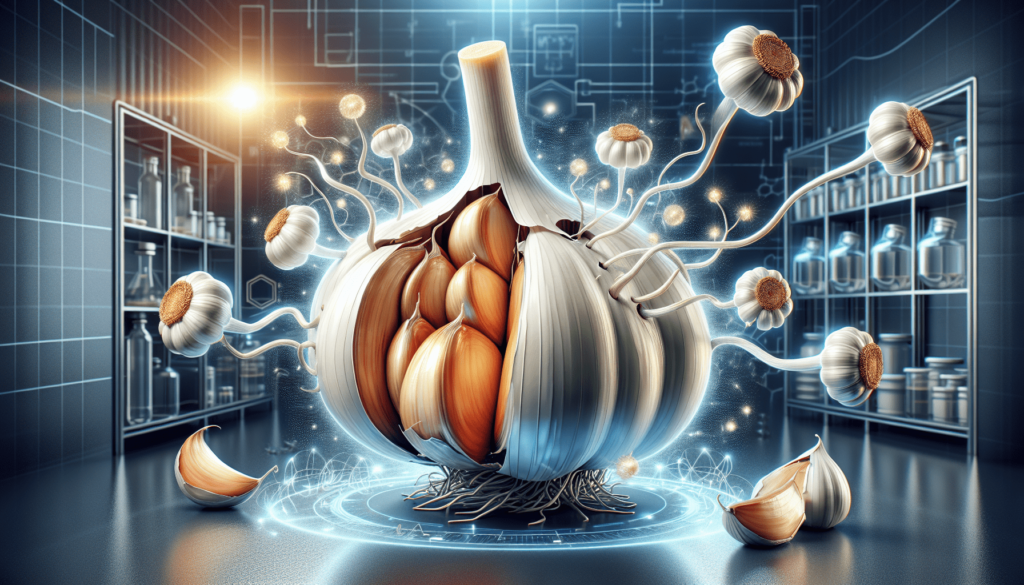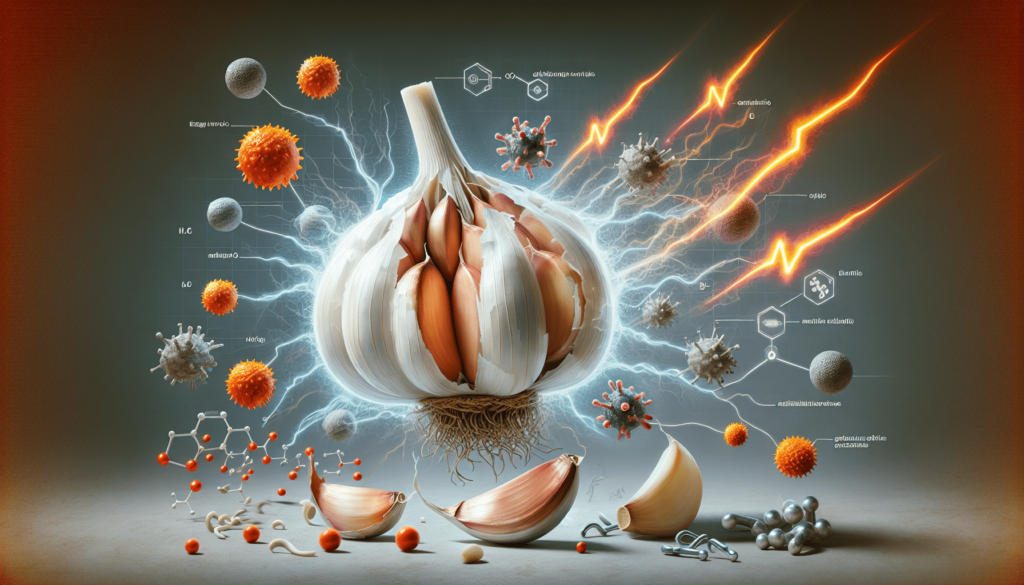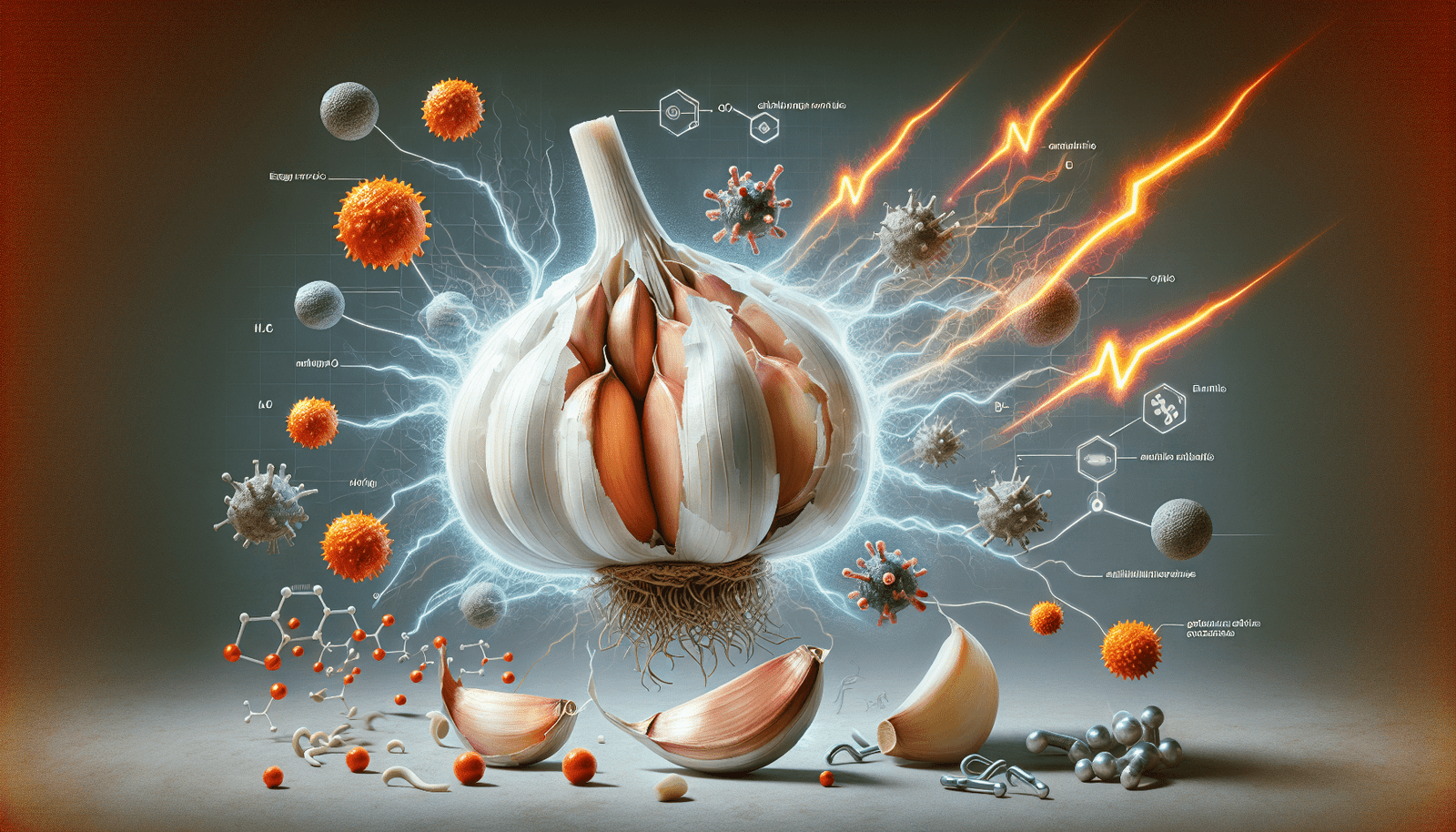In the world of healthy living, where food is your medicine, there is a powerful ingredient that often steals the spotlight – garlic. Known for its distinct flavor and aroma, garlic has long been hailed as nature’s antibiotic. But is this claim truly backed by science, or is it just another health myth? In this article, we will explore the truth about garlic’s potential as an antibiotic, debunking any misconceptions and explaining its true benefits. So join us on this journey of discovery as we uncover the wonders of garlic and its role in our health and well-being. It’s time to separate fact from fiction and embrace the power of this pungent bulb. Welcome to “Garlic: Nature’s Antibiotic, Debunked & Explained.”
Introduction to Garlic
Garlic, with its pungent aroma and distinct flavor, is not only a staple in culinary dishes but also a powerful medicinal herb. Throughout history, garlic has been revered for its numerous health benefits and its ability to ward off illnesses. In this article, we will explore the rich history of garlic as a medicinal herb and its versatile culinary uses. We will also delve into the composition of garlic and the many health benefits it offers.
History of garlic as a medicinal herb
Garlic has been cultivated for over 5,000 years and has a long-standing history as a medicinal plant. Ancient civilizations such as the Egyptians, Babylonians, Greeks, and Romans all recognized the therapeutic properties of garlic. It was used to treat a wide range of ailments, including infections, digestive issues, and respiratory problems. Garlic was even known as a natural remedy for lowering blood pressure and regulating cholesterol levels. Its efficacy as a medicinal herb has stood the test of time and continues to be appreciated in modern times.
Culinary uses of garlic
Beyond its medicinal properties, garlic is a beloved ingredient in various cuisines around the world. Its distinct flavor adds depth and complexity to dishes, making it a staple in many recipes. From sautéed vegetables to savory pasta sauces, garlic brings a delightful taste to a wide range of dishes. It can be used fresh, dried, or even roasted to bring out different flavors and intensities. The versatility of garlic in the culinary world is truly remarkable, and it is hard to imagine many popular dishes without its presence.
Composition of garlic and its health benefits
Garlic owes its impressive health benefits to its unique composition. It is rich in several bioactive compounds, including allicin, sulfur compounds, vitamins, minerals, and antioxidants. Allicin, in particular, is responsible for many of garlic’s medicinal properties. It has been shown to possess antibacterial, antifungal, antiviral, and antioxidant properties. The combination of these compounds makes garlic a potent natural remedy for various health conditions. Consuming garlic in moderation can boost immunity, reduce inflammation, improve cardiovascular health, and even aid in cancer prevention.
Garlic as an Antibiotic
Garlic’s antibacterial properties have been recognized for centuries, making it a remarkable natural alternative to conventional antibiotics. Its ability to combat infections is attributed to the presence of bioactive compounds that target harmful bacteria. In this section, we will delve into the antibacterial properties of garlic, how it fights against infections, and explore the research and studies that support its use as an antibiotic.
The antibacterial properties of garlic
Garlic possesses potent antibacterial properties, making it effective against various strains of bacteria. Studies have shown that garlic extracts can inhibit the growth of both gram-positive and gram-negative bacteria, making it a broad-spectrum antibacterial agent. The sulfur compounds found in garlic, such as diallyl sulfide and ajoene, are particularly effective against bacterial pathogens. These compounds disrupt the bacterial cell membrane, leading to cell death and preventing the growth and survival of harmful bacteria.
How garlic fights against infections
Garlic’s antibacterial action is multifaceted and involves several mechanisms. One of the key ways garlic fights against infections is by inhibiting the production of enzymes that bacteria rely on for survival. Garlic compounds can also interfere with bacterial communication systems, known as quorum sensing, which are vital for bacterial pathogenicity and virulence. Additionally, garlic enhances the production of immune cells and antibodies, assisting the body’s natural defense mechanisms in fighting off infections.
Research and studies on garlic’s antibiotic effects
Numerous studies have been conducted to investigate the antibiotic effects of garlic and its potential as a natural alternative to conventional antibiotics. Research has shown promising results, with garlic extracts demonstrating antibacterial activity against various bacterial strains, including antibiotic-resistant ones. These studies have highlighted the potential of garlic as an effective tool in combating bacterial infections and have paved the way for further research and development in this field.
Garlic’s Mechanism of Action
To truly understand the antibiotic properties of garlic, it is important to explore the mechanisms behind its efficacy. Allicin, the active compound in garlic, plays a central role in garlic’s antibiotic activity. In this section, we will delve into allicin’s mechanism of action, as well as the roles of other bioactive compounds found in garlic.
Allicin: the active compound in garlic
Allicin is a sulfur-containing compound that is formed when garlic is crushed or chopped. It is responsible for the strong odor and distinct flavor of garlic. When consumed, allicin is converted into other sulfur compounds with antibacterial properties. This conversion process is facilitated by an enzyme called alliinase, which is present in garlic. Allicin’s stability and bioavailability are key factors in determining its potency as an antibiotic.
How allicin works as an antibiotic
Allicin exhibits antibacterial activity by attacking various components of bacterial cells. It disrupts the cell membrane, inhibits DNA replication, and interferes with cell metabolism, leading to bacterial cell death. Allicin’s mode of action makes it effective against both Gram-positive and Gram-negative bacteria, as well as certain fungi. Its ability to target multiple bacterial processes makes it a potent antibiotic agent.
Other bioactive compounds in garlic and their roles
While allicin is the star player in garlic’s antibiotic activity, other bioactive compounds also contribute to its health benefits. Sulfur compounds, such as ajoene and diallyl sulfide, possess antibacterial properties and work in synergy with allicin. Garlic is also rich in antioxidants, which help protect the body against oxidative stress and reduce inflammation. These compounds, along with vitamins and minerals found in garlic, contribute to its overall health-promoting properties.

Effectiveness of Garlic as an Antibiotic
As garlic gains recognition as a natural antibiotic, it is essential to assess its effectiveness compared to conventional antibiotics. In this section, we will compare garlic’s efficacy with traditional antibiotics, discuss the limitations and considerations of using garlic as an antibiotic, and explore how to choose the right garlic preparation for maximum effectiveness.
Comparison with conventional antibiotics
Garlic’s effectiveness as an antibiotic has been demonstrated in various studies, showing comparable or even superior results to conventional antibiotics in some cases. One advantage of garlic over traditional antibiotics is its broad-spectrum activity against different bacterial strains, including antibiotic-resistant ones. However, it is important to note that the potency of garlic’s antibiotic effects can vary depending on factors such as preparation methods, dosage, and the specific bacterial strain being targeted.
Limitations and considerations of using garlic as an antibiotic
While garlic shows great potential as an antibiotic, it is crucial to consider its limitations. Garlic’s antibacterial properties may be effective against certain bacterial strains, but it may not be as effective against others. Moreover, garlic’s antibiotic effects are generally milder and may take longer to show results compared to conventional antibiotics. It is also essential to note that garlic should not replace professional medical advice, and severe infections may still require the use of conventional antibiotics.
Choosing the right garlic preparation for maximum effectiveness
To maximize the antibiotic effects of garlic, it is important to choose the right preparation method. Allicin, the active compound responsible for garlic’s antibiotic properties, is relatively unstable and can be easily degraded by heat, prolonged storage, or cooking. Consuming raw garlic or using garlic extracts rich in allicin content are optimal ways to ensure maximum effectiveness. However, if raw garlic is not tolerable due to its pungent flavor, aged garlic supplements can also provide a significant amount of beneficial compounds.
Garlic for Common Infections
Garlic’s antibiotic properties make it a valuable natural remedy for various types of infections. In this section, we will explore how garlic can be used to combat respiratory infections, skin infections, digestive infections, and urinary tract infections.
Garlic for respiratory infections
Garlic’s antibacterial and antiviral properties make it an excellent choice for respiratory infections such as colds, flu, and sinusitis. Consuming garlic in its raw form or as garlic supplements can help alleviate symptoms and reduce the duration of respiratory infections. The antimicrobial activity of garlic can help fight off the pathogens responsible for these infections while boosting the immune system’s ability to defend the body against further infections.
Garlic for skin infections
Garlic’s potent antibacterial properties can also be beneficial in treating skin infections, such as acne, fungal infections, and minor wounds. Applying a garlic paste or oil topically to the affected area can help eliminate the harmful bacteria and promote wound healing. However, it is important to exercise caution and do a patch test before applying garlic topically, as it may cause skin irritation in some individuals.
Garlic for digestive infections
Digestive infections, such as food poisoning and gastrointestinal bacterial infections, can be effectively combated with garlic’s antibacterial activity. Garlic can help eliminate harmful bacteria in the digestive tract, reducing symptoms like diarrhea, abdominal pain, and nausea. Consuming garlic either raw or cooked as part of a balanced diet can support gastrointestinal health and aid in the recovery from digestive infections.
Garlic for urinary tract infections
Urinary tract infections (UTIs) are common, especially in women, and garlic can serve as a complementary treatment option. Garlic’s antibacterial properties can help eliminate the bacteria responsible for UTIs and prevent their recurrence. Incorporating garlic into the diet or taking garlic supplements can contribute to urinary tract health and reduce the risk of UTIs.
Garlic’s Potential for Drug Resistance
As with any antibiotic, the risk of bacterial resistance to garlic should be considered. In this section, we will explore whether bacteria can develop resistance to garlic, how to minimize the risk of resistance, and the potential of combining garlic with other natural antibiotics.
Can bacteria develop resistance to garlic?
Bacterial resistance to antibiotics is a growing concern in modern medicine. While garlic’s antibacterial properties have shown effectiveness against various bacterial strains, there is still a possibility of bacteria developing resistance. However, the likelihood of bacterial resistance to garlic is relatively low compared to conventional antibiotics. The combination of multiple bioactive compounds in garlic may make it more difficult for bacteria to develop resistance.
How to minimize the risk of resistance
To minimize the risk of bacterial resistance to garlic, it is essential to use garlic judiciously. It is recommended to rotate the use of garlic with other natural antibiotics to prevent the overuse of any single agent. Additionally, maintaining good hygiene practices, such as proper handwashing and food preparation, can help reduce the spread of antibiotic-resistant bacteria.

Combining garlic with other natural antibiotics
Combining garlic with other natural antibiotics can enhance its effectiveness and potentially reduce the risk of resistance. Some natural antibiotics, such as oregano oil, honey, and turmeric, possess their own antimicrobial properties and can work synergistically with garlic. The combination of multiple natural antibiotics can create a more powerful defense against bacterial infections while reducing the reliance on conventional antibiotics.
Debunking Garlic Myths
Garlic has gained a reputation as a cure-all for various ailments. However, it is important to separate fact from fiction regarding its effectiveness. In this section, we will debunk common garlic myths, including its ability to cure all diseases, its effectiveness against viral infections, and whether raw garlic provides more benefits than cooked garlic.
Garlic as a cure-all
While garlic possesses impressive health benefits and antimicrobial properties, it is not a cure-all for all diseases. Garlic should be viewed as a complementary treatment option and should not replace professional medical advice or conventional treatments for serious illnesses. It is important to maintain a balanced and holistic approach to healthcare, incorporating garlic as part of a healthy lifestyle rather than relying solely on it for all ailments.
Garlic’s effectiveness against viral infections
Garlic is commonly believed to be effective against viral infections, including the common cold and influenza. While garlic does possess antiviral properties, its effectiveness against viral infections is relatively limited compared to its antibacterial effects. Garlic’s antiviral activity may help alleviate symptoms and support the immune system, but it is not a definitive cure for viral infections.
Does raw garlic provide more benefits than cooked garlic?
There is a common misconception that raw garlic provides more health benefits than cooked garlic. While raw garlic does retain higher levels of allicin, which is responsible for many of garlic’s medicinal properties, cooked garlic still offers numerous health benefits. Cooking garlic can actually enhance its antioxidant and anti-inflammatory properties. The key is to find a balance between consuming raw and cooked garlic to optimize its health benefits.
Safe Usage and Possible Side Effects
While garlic is generally safe for consumption, it is important to consider the recommended dosage, potential side effects, and precautions for certain medical conditions. In this section, we will discuss the recommended dosage and frequency of garlic consumption, potential side effects, and interactions with medication.
Recommended dosage and frequency
The recommended dosage of garlic varies depending on the form and preparation method. Consuming one to two fresh garlic cloves per day is generally considered safe and beneficial for most individuals. However, if using garlic supplements, it is essential to follow the recommended dosage instructions provided by the manufacturer. Moderation is key, and it is advisable to consult with a healthcare professional for personalized advice regarding garlic consumption.
Potential side effects of consuming garlic
While garlic is well-tolerated by most people, it can cause certain side effects in some individuals. Common side effects include bad breath, body odor, heartburn, and gastrointestinal discomfort. Garlic may also interact with certain medications, so it is important to be aware of potential drug interactions. Individuals who experience severe allergic reactions or have bleeding disorders should exercise caution when consuming garlic and consult with a healthcare professional if necessary.
Precautions for certain medical conditions
Garlic consumption may need to be limited or avoided altogether in certain medical conditions. Individuals taking blood-thinning medications, such as warfarin, should consult with a healthcare professional before consuming garlic, as it can interact with these medications. Additionally, individuals with stomach ulcers, acid reflux, or sensitive digestive systems may experience worsened symptoms with garlic consumption. It is best to consult with a healthcare professional if there are any concerns about garlic’s suitability for specific medical conditions.
Interactions with medication
Garlic may interact with certain medications, particularly blood-thinning medications, anticoagulants, and antiplatelet drugs. Garlic can potentiate the effects of these medications, increasing the risk of bleeding. It is important to inform healthcare professionals about garlic consumption when prescribed medication to ensure safe and effective treatment. Adjustments may be required in medication dosages or garlic consumption to minimize potential interactions.
Other Health Benefits of Garlic
Beyond its antibiotic properties, garlic offers a range of other health benefits. In this section, we will explore garlic’s role in cardiovascular health, its potential impact on cancer prevention, its influence on immune function, and its positive effects on digestive health.
Garlic’s role in cardiovascular health
Garlic has long been recognized for its positive impact on cardiovascular health. It can help lower blood pressure, reduce cholesterol levels, and improve blood circulation. Garlic’s ability to reduce oxidative stress and inflammation further supports heart health. Regular consumption of garlic, as part of a heart-healthy diet and lifestyle, can contribute to the prevention of cardiovascular diseases.
Garlic and cancer prevention
Studies have shown that garlic possesses cancer-fighting properties and may help prevent certain types of cancer, particularly in the digestive system. The bioactive compounds found in garlic, such as organosulfur compounds and antioxidants, have been shown to inhibit the growth and proliferation of cancer cells. Incorporating garlic into a balanced diet rich in fruits and vegetables can contribute to a reduced risk of developing certain cancers.
Garlic’s impact on immune function
Garlic has been revered for its immune-boosting properties throughout history. Its antibacterial, antiviral, and antifungal properties, along with its ability to enhance the production of immune cells and antibodies, make it a valuable ally in supporting immune function. Consuming garlic regularly can help strengthen the immune system and reduce the risk of infections.
Garlic and digestive health
Garlic plays a beneficial role in maintaining digestive health and promoting a healthy gut microbiome. Its antibacterial properties can help eliminate harmful bacteria in the digestive tract, while its prebiotic properties nourish beneficial gut bacteria. Garlic can aid in digestion, alleviate symptoms of gastrointestinal disorders, and support overall digestive health when consumed as part of a balanced diet.
Conclusion
In summary, garlic truly deserves its title as nature’s antibiotic. Its rich history as a medicinal herb and versatile culinary ingredient highlights its widespread recognition and usefulness. Garlic’s antibacterial properties, attributed to compounds such as allicin, make it a potent natural antibiotic that can combat various infections. While garlic may not replace conventional antibiotics in all cases, it offers a promising alternative with fewer side effects and a lower risk of resistance. Incorporating garlic into a balanced diet can provide numerous health benefits, including its potential to promote cardiovascular health, aid in cancer prevention, enhance immune function, and support digestive health. As you embark on your journey towards a healthier lifestyle, don’t forget to embrace the wonders of garlic and unlock the full potential of nature’s antibiotic.

